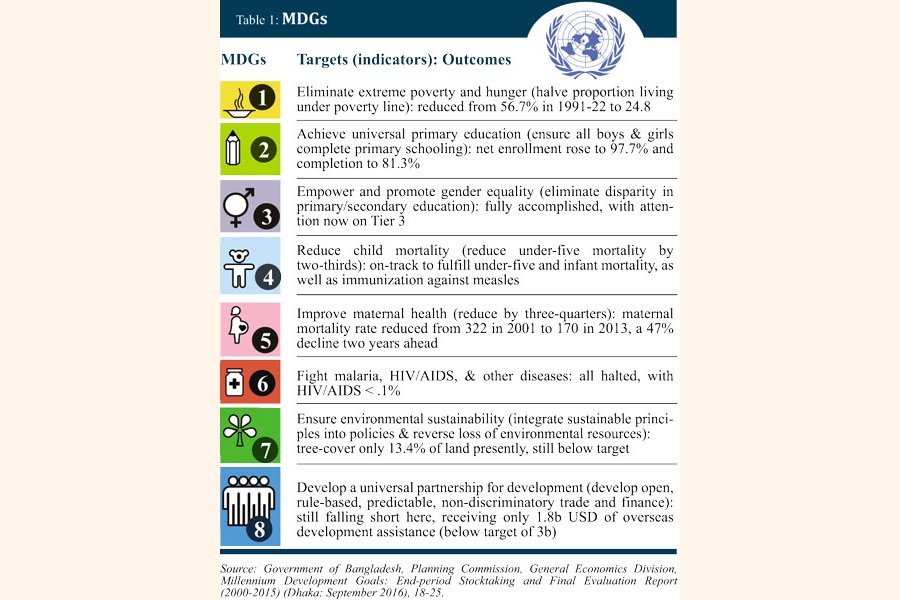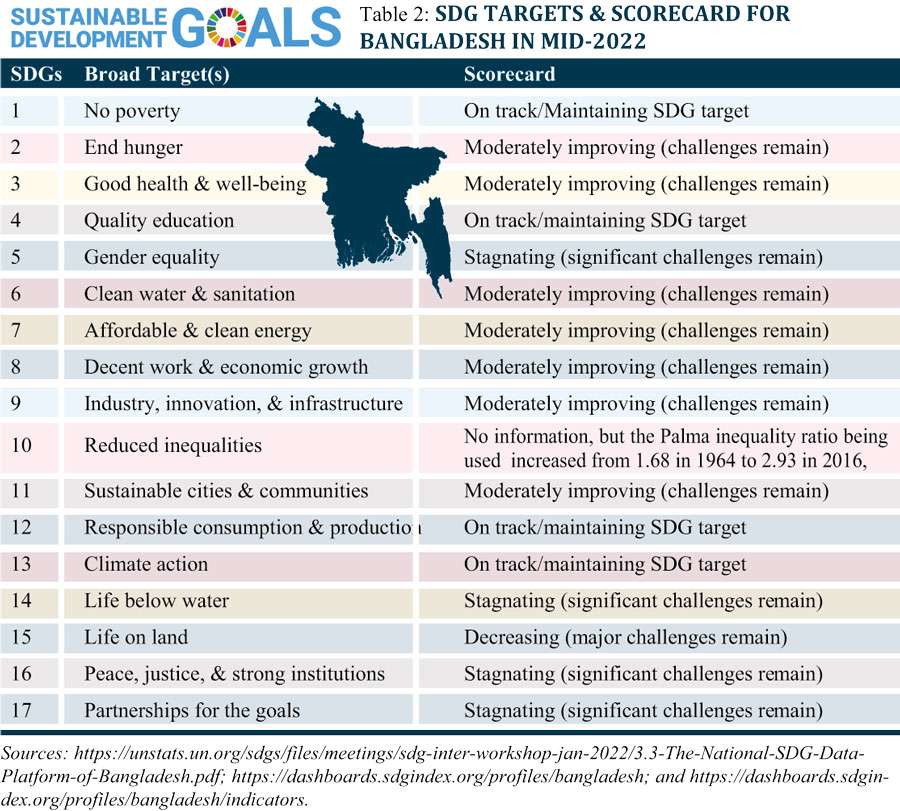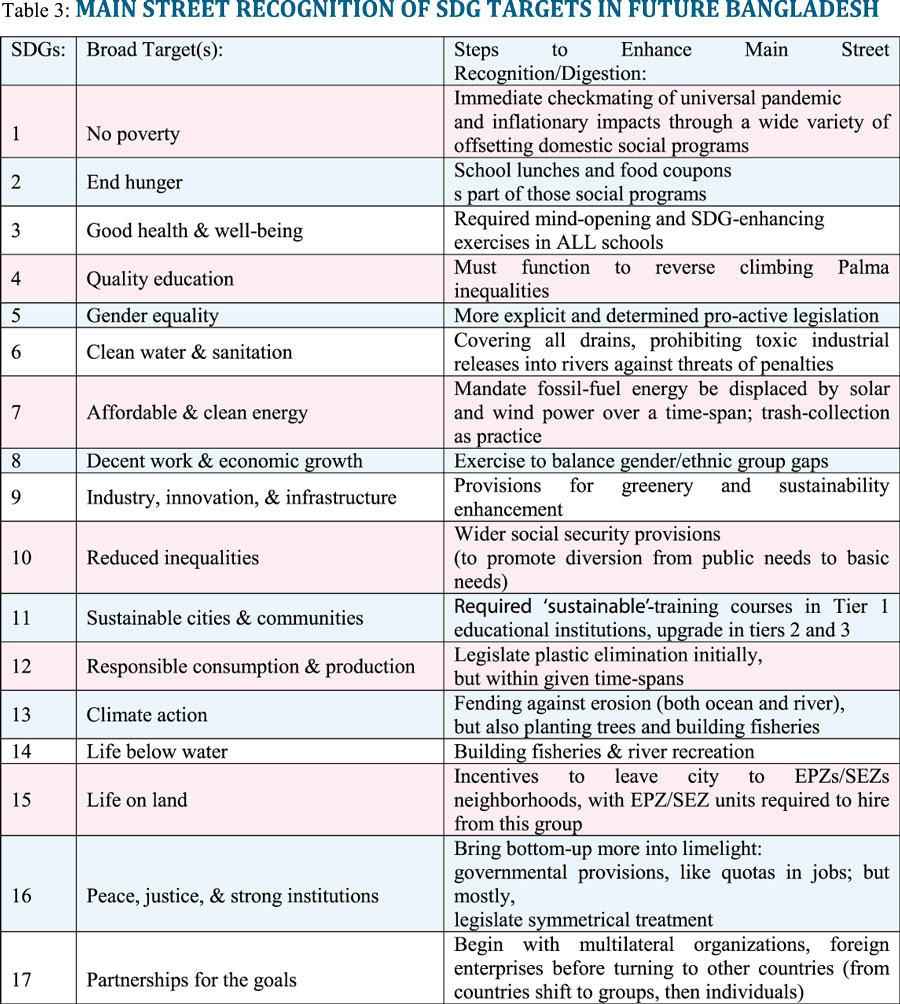
 With eight years left to fulfill the Sustainable Development Goals (SDGs) mandate, Bangladesh is moving into an uphill stretch. Two successive problems -- corona virus (COVID)-19 from 2020 and an inflationary spiral from mid-2022 --have complicated the progress. Commitments first made in the United Nations by 189 countries to adopt a Millennium Development Goals (MDGs) mandate in September 2000, meant eight targets had to be fulfilled in 15 years. Bangladesh scraped through, as Table 1 shows. It then naturally joined 192 other countries on September 25, 2015 for another 15-year, SDG cleansing/corrective journey. Known as Agenda 2030, its 17 'global goals', carried 169 specific targets and 232 measurable indicators. As observed in another context, these small country-specific steps could become one giant leap for humankind.
With eight years left to fulfill the Sustainable Development Goals (SDGs) mandate, Bangladesh is moving into an uphill stretch. Two successive problems -- corona virus (COVID)-19 from 2020 and an inflationary spiral from mid-2022 --have complicated the progress. Commitments first made in the United Nations by 189 countries to adopt a Millennium Development Goals (MDGs) mandate in September 2000, meant eight targets had to be fulfilled in 15 years. Bangladesh scraped through, as Table 1 shows. It then naturally joined 192 other countries on September 25, 2015 for another 15-year, SDG cleansing/corrective journey. Known as Agenda 2030, its 17 'global goals', carried 169 specific targets and 232 measurable indicators. As observed in another context, these small country-specific steps could become one giant leap for humankind.
Do Bangladesh's performances show optimism or pessimism? Must those alluded secular exogenous forces (the pandemic, war-driven inflation) hijack the most collective effort in recorded history? Ultimately will Bangladesh relapse into its familiar pattern of failing to see the 'big-picture' because of unnecessarily basking in 'little-league' glorification?
Table 2 spells out the SDG mandate. Narration begins with the big global picture before Bangladesh, then narrows to assess its specific performances.
Forest in Bangladesh's SDG Quest: Bangladesh's aggregate current SDG score of 64.2 today is its best score in four-years of record-keeping. Ranked 104th out of 163 countries on that list this year, Bangladesh falls midway between the best score, Finland's (86.5), and the worst, South Sudan's (39.05).
Europe dominates the top-25 on that list, with Japan being the only 'outsider', at #19, with a 79.58 score. Four other continents knock on that club-door: New Zealand, Republic of Korea, Chile, and Canada, respectively at #26, #27, #28, and #29. In Bangladesh's neighborhood, Thailand ranks the highest, at #44 (74.13), followed by Singapore at #60 (71.73), Maldives #67 (71.03), Bhutan #70 (70.49), Malaysia # 72 (70.38), Sri Lanka #76 (70.03), Nepal # 98 (66.18), Myanmar #103 (64.27), India # 121 (60.32), and Pakistan #125 (59.34).
External/Exogenous forces have rattled those scores most in 2022: civil war (as in Sri Lanka), international war, as in Ukraine (all countries of the world impacted by strains on food supplies, energy availabilities, and the resultant inflation); monsoon floods (Pakistan), climate threats (global this year), and drought (plaguing Africa). Pushing scores upwards will be harder retaining the present scores more challenging.
Around Bangladesh's 64.22 score lie so many other countries. Only concerted and determined efforts can push the country not just upwards, but ascent with leaps and bounds. Its ranking this year is five notches better than the previous year's, when it scored 63.5, just as it was #116 in 2020 with a 60.9 score, #116 in 2019 with 60.8; and #111 in 2018 with a score of 59.3 in 2018 (with only 157 countries in this, the first year of data availability). This snail-paced climbing demands renewed determination to rise above both the external/exogenous and internal/endogenous constraints to fulfilling SDG commitments. In addition to signing the 1999 MDG and 2015 SDG commitments, Bangladesh's 1971 Sonar Bangla dream was dubbed a 'developed country' (DC) by Vision 2041. Thus, a lot more rides upon the country's SDG innings to deliver to its hopeful citizens.
Here is how the chart looks where Bangladesh is currently situated. Within 3 points of Bangladesh's 2022 score of 64.22 on this side or that lie 25 other countries. The following countries lie immediately ahead of Bangladesh in that selected margin (with scores ranging from 64.27 to 67.43): Paraguay, Nicaragua, Brunei, Darussalam, Qatar, the Philippines, Saudi Arabia, Lebanon, Nepal, Turkmenistan, Belize, Kuwait, Bahrain, and Myanmar. Note how Bangladesh hosts 1.2 million refugees (in the largest global camp) from the very country one rank higher. We cannot rely on that country's civil war to overtake it. We must rely on our own resources.
Similarly, the following countries rank behind Bangladesh within that selected margin (with scores descending from 64.0 to 61.43): Panama, Guyana, Cambodia, South Africa, Mongolia, Ghana, Lao PDR, Honduras, Gabon, Namibia, Iraq, and Botswana. There are enough countries in this group to give Bangladesh a run for its money, in case we slip. Many of them face more grievous post-Ukraine war and inflationary crises, but also stubborn internal divisions to pay SDG rankings any priority. That should not mean we lower our guard.
One must first consider secular developments impinging the SDG crusade before the dimension-specific problematic areas indicated in Table 1.
Secular developments include those Bangladesh cannot control and which impact other countries symmetrically, albeit with different degrees of consequences. These include the aforementioned features: international war, particularly in Ukraine, jolting both food and energy prices, nibbling away at SDG2 but also SDG8-12; climate-dictated weather-related developments, as Pakistan's floods really coming out of the blue while rivers in Bangladesh and India, the historical venues of Monsoon and floods, receiving less water from Himalayan glaciers this year; and of course the corona virus-19 lingering effects after a draconian first couple of years, but still powerful enough to divert public SDG attention. COVID fatalities remain high: 29,416 deaths by October 25, 2022, with 196 new infections in the previous 24 hours, and 3,913 new tests just in the previous 24 hours for a total of 14,985,855.
Vision 2041's DC outcome necessarily entails industrialization. Moving up the value-chain from a low-income, low-skilled RMG (ready-made garment) mainstay to higher income (hopefully salaries rather than wages by the 2040s for the majority), and higher-skills platforms, means shifting from physical labor in factory assembly-lines (hardware) to intellectual (software), with information technologies (IT) as a platform. These tax the entire SDG philosophy: how to (a) list the absence of waste management; (b) substitute several items routinely utilized, like plastic; (c) demand more energy supplies, thus paving the way for fossil fuel usage; (d) accent equality and gender strikes; and ultimately (e) leave more inchoate socio-cultural and political economic consequences than a single-minded SDG crusade can handle.
Exogenous developments aside, recognizing and crediting positive consequences of internal and endogenous dynamics seems commensurate to both attaining a DC status and enhancing the SDG ambience. Many of Bangladesh's megaprojects will be completed by 2041, strengthening and leaving more resilient infrastructures, from highways and ports to distribution and communications channels, in turn generating employment and consumption both quantitatively and qualitatively. More citizens would be alerted to SDG requisites and pathways, thus broadening possible 'champions' of various social causes and enhancing the SDG or DC cause. In turn, health facilities, food availabilities, education, and the desire to shift from blindsided waste to a more calibrated treatment of nature can only grow (whether to adequate levels or not we are still unsure of). Infinite ripple-effects will need more care and foresight now.
Yet, the SDG movement can also be hijacked from within by the clear inability to deliver some of the targeted areas. Here lay the final straws impinging assessments.
 Since the SDGs and DC playgrounds carry a modern approach to life that did not necessarily affect policies before, certain traditional/cultural habits might get in the way. Transiting from the latter to the former will be difficult and very sensitive. For example, only a few of Dhaka's citizens know the harm created by throwing garbage anywhere outside the house. How do we instill this mindset on those not educated enough to know when historically this was not a concern? Today's trash, furthermore, includes high proportion of plastic in it, therefore becoming more organically harmful to humans and the environment than any counterpart commodity before the industrial age, which is still part of the traditional lore. Instilling such a concern on Main Street involves an awareness program that plants SDG policies and knowledge in the common person's vocabulary and mindset. Who will do that? How do we measure outcome-changes? Who picks up the tab? Which ministry takes collective responsibility?
Since the SDGs and DC playgrounds carry a modern approach to life that did not necessarily affect policies before, certain traditional/cultural habits might get in the way. Transiting from the latter to the former will be difficult and very sensitive. For example, only a few of Dhaka's citizens know the harm created by throwing garbage anywhere outside the house. How do we instill this mindset on those not educated enough to know when historically this was not a concern? Today's trash, furthermore, includes high proportion of plastic in it, therefore becoming more organically harmful to humans and the environment than any counterpart commodity before the industrial age, which is still part of the traditional lore. Instilling such a concern on Main Street involves an awareness program that plants SDG policies and knowledge in the common person's vocabulary and mindset. Who will do that? How do we measure outcome-changes? Who picks up the tab? Which ministry takes collective responsibility?
The following will be assessed below (in no order and without any presumptions), before the essay's third section converts SDG mandates into Main Street cognizance, that is, recognition by even the most uneducated and incognizant citizens rather than just ivory-tower philosophers, policy-makers, or perpetual critics. The idea is to collective push so the SDG mandate is collectively understood, pushed, attained, and eventually relished by the 'clean', 'responsible' DC Bangladesh citizens. This is arguably the 'be-all and end-all' of this crusade.
Trees in Bangladesh's SDG Forest: Three SDG drives raise concern: SDG7 (affordable and clean energy), SDG10 (reduced inequalities), for which information is not given, and SDG15 (life on land), could move in the wrong direction and pose major challenges, not to mention the increasingly hostile pandemic-haunted, inflation-bugged atmosphere. For SDG7, whereas the share of renewable energy in total primary energy supply has plummeted, making the 10% share of total primary energy unlikely, the proportion of the population with access to clean fuel and technology for cooking poses still falls below the targeted 100%. Here are classic cases of secular forces interrupting SDG pathways: the 2040s DC target cannot be met until renewable energy supply is more standardized and widely available. On the one hand, SDG7 exposes the lack of a coordinated policy-specific approach to building renewable energy and the slow transition to supply them and institutionalize that supply network. This missing coordination is between ministries, between corporations, between individuals, and between all of the above with each other: the mission cannot be treated in a laissez-faire competitive way 'of, for, and by' only the stakeholders. On the other, Bangladesh's remarkable strides with solar energy in pocketed rural areas have simply not found SDG7 replication and spread-effects. Both aforementioned SDG7 indicators would show vast improvements if we simply recalibrate attention and resources rather than lament their absence or short-supply. The free-market cannot determine the SDG fate.
Similarly with SDG10, for which the income-inequality reduction indicators include reducing the income ratio of the top-10% versus the bottom-10% to 20%; and reduce the recruitment cost of employees (in migrant-sending countries) of their income (in destination countries), to 10%.
 The obvious failing indicator conspicuously stares at us (the robustly ascending Palma inequality figures): how the 1964 ratio of 1.69 had skyrocketed to 2.93 by 2016, before measuring SDG progress would even begin. Though no later figures have been found, Bangladesh's superlative growth-rate in this century (from the 1990s, in fact), impressively downsized poverty-levels. Yet, though those in the lower rungs now live a better life, the gap with the upper rungs have miserably widened. Part of the reason why may be because the low-wage RMG structure remains ever-strong, refusing to budge (and making our DC aspirations look hollow), even within a context of high-wage/high-skilled hi-tech parks being built to accelerate the DC shift. Public sector intervention must override patronage.
The obvious failing indicator conspicuously stares at us (the robustly ascending Palma inequality figures): how the 1964 ratio of 1.69 had skyrocketed to 2.93 by 2016, before measuring SDG progress would even begin. Though no later figures have been found, Bangladesh's superlative growth-rate in this century (from the 1990s, in fact), impressively downsized poverty-levels. Yet, though those in the lower rungs now live a better life, the gap with the upper rungs have miserably widened. Part of the reason why may be because the low-wage RMG structure remains ever-strong, refusing to budge (and making our DC aspirations look hollow), even within a context of high-wage/high-skilled hi-tech parks being built to accelerate the DC shift. Public sector intervention must override patronage.
Even the second indicator exposes a low-wage bug: with so many migrants being recruited for work abroad, Bangladesh has been more interested in the net effects (of remittances flowing in), particularly during the pandemic, than in finessing the nature and terms of their recruitment. Whether they go to Southeast Asian or Middle East countries, similar stories of human trafficking, low-wage exploitation producing no-wage outcomes, and ostracized, inferior-class treatment complicate their stay, making wage adjustments to SDG expectations meaningless. This is as much a diplomatic task as it is personal and business-based. Without symmetrical citizenship treatment of migrants in both home and host countries, Bangladesh will not alone be hindered by incorrigible migrant terms. SDG10 misuse will also thwart the DC cherished target of pushing civilians towards a more symmetrically 'graduating' country.
Deteriorating SDG15 performances cannot all be attributed to pandemic impacts after 2022, nor after the mid-2022 price-hikes jolted SDG priorities. With an exploding population now approaching 170 million and 1.2 displaced persons in Cox's Bazaar's hillsides to cater to, it is an increasingly mountainous task to retain land, even worse, to promote any greenery or environmental programs. Increasing forestry to over 18% of total land area took a hit when trees had to be chopped down for Kutupalong and other refugee camps, but diligent restoration efforts, particularly in Kutupalong, often go without recognition. Replanted trees will likely blossom after the 2030s, but the toll the DC push places by building industries (economic zones), demands a similar rectification. Private sector businesses traditionally place profits over sustainability (ours all the more so given our patronage-infected social and economic strictures), and although government-managed export processing zones (EPZs) and special economic zones (SEZs) could show the way, sustainability bench-marks, training, and experience could also help.
Raising tree-covered land to 25% and forest-land to 18% of overall land-space will be increasingly harder to fulfill given the onset of climate-change weather-related crises, imperatives of eliminating urban slum-areas, and eventually depopulating metropolitans. Unless given more urgency, this particular SDG commitment would eventually complicate SDG14 (life on water), and both thwart SDG16 (strengthening institutions), and SDG17 (strengthening partnerships). Without these, the entire SDG house could come crumbling down.
Resurrecting the SDG crusade needs giving it more of a personal touch, particularly engaging more than policy-makers, educated, the erudite, or the pragmatic persons. Enhancing bottom-up activation and results must become a part and parcel of the game if it is to succeed. Without Main Street citizens having a buzzword, message, or even imperative on their lips, mindset, and indeed action, SDG relevance would remain "of the few, by the few, and for the few." Reconstructing Table 2 by interpreting the SDG mission and instruments to fit the layperson's vocabulary and mindset could be a start. Table 3 is a start.
Against the back-to-back secular threats bashing peoples worldwide, especially those in the middle social ranks, at the margin, and the plenty below all of the above, the SDG campaign is precipitously poised: it could easily collapse, but herculean efforts now would raise it into an accomplishment tall enough for all to not just see, but also admire, ingrain, and inspire. Resurrecting that campaign at the base, that is, Main Street (or a typical bazaar), energizes the average citizen. By dirtying his/her own hands, they give us a sure sign of the job being done by the very persons hitherto unwittingly contributing to the problem: only when the typical citizen is 'turned on' practically (rather than conversationally) can a movement be ignited, flow, and grow.
Accordingly, reframing the SDG list to meet the new and growing challenges must elicit a similar governmental response, much like how it first confronted the COVID outbreak, that is, from April 2020, with so much largesse. Digging deep, this time for longer-term and more sustainable success than just band-aid type of action gives the unknown future a tangible face so everyone knows what each purpose is, how much better society would be if each person plunged into it compared to what they see now, and why prolonging future mileage adds incentives of further securing the next generation's, that is, theirs children's, playing-grounds.
Ending poverty and hunger makes no sense without a plan against a looming inflation. The government could begin with a works program, legislating more social security and health provisions, reconfiguring curricula particularly at the lower end (primary schools) to ingrain and popularize the habits necessary for SDG delivery and sustenance, and most of all, pegging each ministry with other ministries so the prevalent silo-mentality gets replaced by a more collective, coordinated, and comprehensive approach everyone knows everything about.
One such work program could address independent long-term threats, such as strengthening coastlines against rising ocean-levels, riverbanks against erosion, and a purposeful and never-ending tree-planting campaign across the country. Such an initiative would revitalize SDG1 to prevent communities from sliding into poverty from ecological threats; ensure SDG2 guarantees against hunger; push SDG6 to augment water supplies, and with it enhance proper sanitation habits (opening multiple times more metropolitan public toilets would conveniently slide into this workload to deliver desired goals); augment SDG8 to not only supply work, and thereby keep economic growth ongoing, but to breed more respect for the new types of public work; help SDG10 to reduce growing inequalities; facilitate SDG11 to generate new metropolitan hopes with new functions; and give SDG16 another reason to show a fairer and more judicious face through the very nature of the work. Above references to the 'public' only make sense if, and only if, the message that 'public' means the 'public', specifically, 'you and I', is purposefully disseminated to every stakeholder;.
While a works program would have indirect and spillover impacts of a positive nature elsewhere on the list (some immediately, others over time), supplementing that proposal with a wider and more formal and better structured social security system would (a) help SDG3 enhance its claims to bettering health and well-being; (b) extend SDG4 to a broader public-base, especially through a mandatory nutritious lunch in all public schools; (c) feed SDG5 so girls get as much of a chance as boys, but also push their already better class performances and examination results to even higher levels (since, after a history of being subordinated players, differential margins with males/boys must be commensurately higher if only to build the confidence so absent in every empowerment action or measurement); (d) strengthen SDG9 infrastructures, especially at the social level; (e) elevate SDG12 by making consumption and production more responsible (eliminating plastic through, and building a green mindset upon, school-training and exercises, such as supervising stretches of public property, like residential/commercial/recreational blocks or agricultural lands, even lakes and rivers); (f) enhance SDG12 climate action through the above proposals; and (g) build SDG17 partnerships for both internal SDG coherence and cohesiveness as well as external SDG coordination.
No SDG boat would be too big even if Bangladesh's entire population is included. It was what Bangabandhu wanted, all of Bangladesh. It was what diplomats and policy-makers framing both NDG and SDG responses had in mind. Indeed, not having that outcome literally means missing the SDG boat and abandoning our Sonar Bangla DC goal purposefully because the mission, logistics, and outcomes did not galvanize every citizen. That that is not the case is for us to show now. And there not be a second opportunity.
Professor Imtiaz A. Hussain is a teacher at the Department of Global Studies & Governance (GSG), Independent University, Bangladesh (IUB).
imtiaz.hussain@iub.edu.bd
© 2026 - All Rights with The Financial Express
